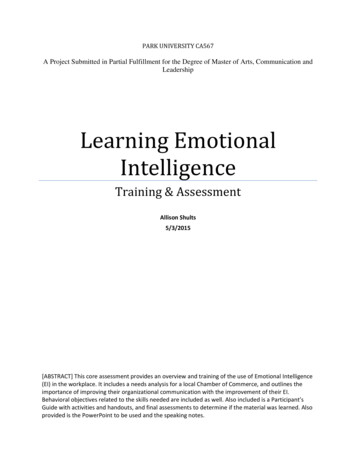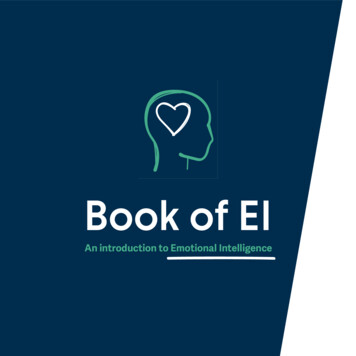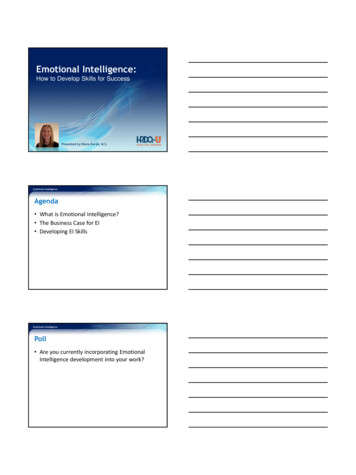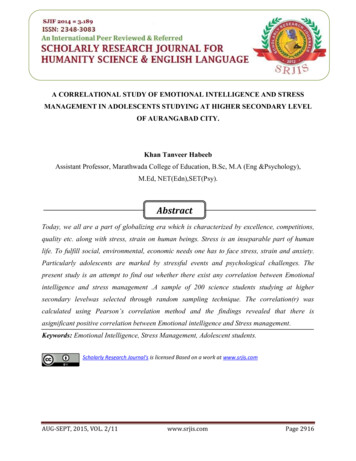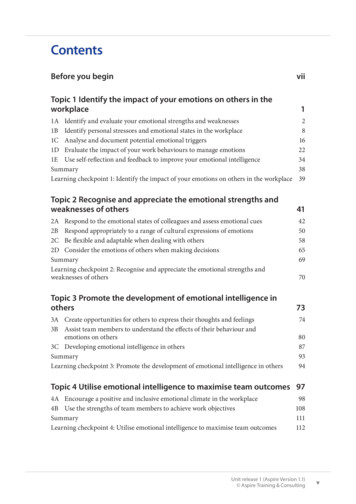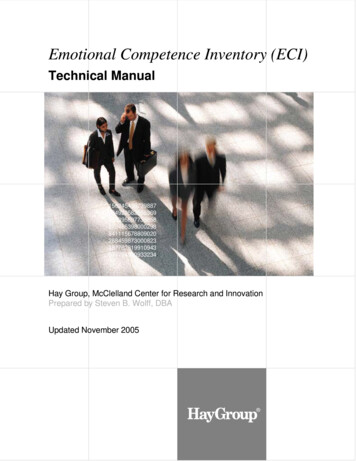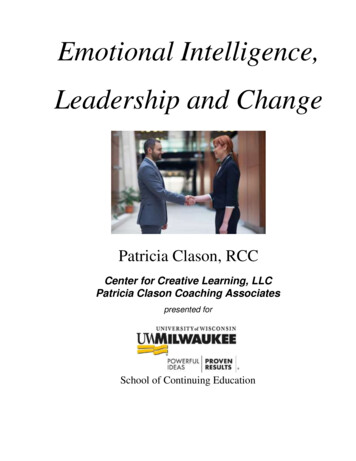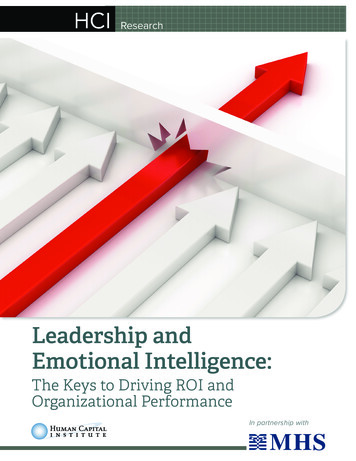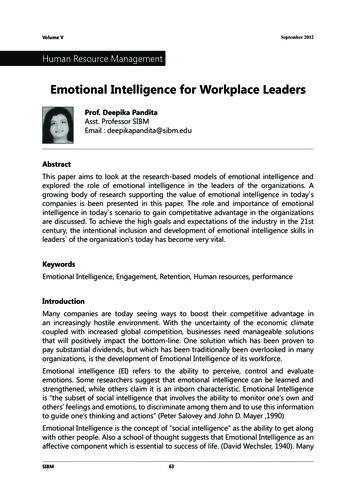
Transcription
September 2012Volume VHuman Resource ManagementEmotional Intelligence for Workplace LeadersProf. Deepika PanditaAsst. Professor SIBMEmail : deepikapandita@sibm.eduAbstractThis paper aims to look at the research-based models of emotional intelligence andexplored the role of emotional intelligence in the leaders of the organizations. Agrowing body of research supporting the value of emotional intelligence in today scompanies is been presented in this paper. The role and importance of emotionalintelligence in today s scenario to gain competitative advantage in the organizationsare discussed. To achieve the high goals and expectations of the industry in the 21stcentury, the intentional inclusion and development of emotional intelligence skills inleaders of the organization’s today has become very vital.KeywordsEmotional Intelligence, Engagement, Retention, Human resources, performanceIntroductionMany companies are today seeing ways to boost their competitive advantage inan increasingly hostile environment. With the uncertainty of the economic climatecoupled with increased global competition, businesses need manageable solutionsthat will positively impact the bottom-line. One solution which has been proven topay substantial dividends, but which has been traditionally been overlooked in manyorganizations, is the development of Emotional Intelligence of its workforce.Emotional intelligence (EI) refers to the ability to perceive, control and evaluateemotions. Some researchers suggest that emotional intelligence can be learned andstrengthened, while others claim it is an inborn characteristic. Emotional Intelligenceis “the subset of social intelligence that involves the ability to monitor one’s own andothers’ feelings and emotions, to discriminate among them and to use this informationto guide one’s thinking and actions” (Peter Salovey and John D. Mayer ,1990)Emotional Intelligence is the concept of “social intelligence” as the ability to get alongwith other people. Also a school of thought suggests that Emotional Intelligence as anaffective component which is essential to success of life. (David Wechsler, 1940). ManySIBM63
September 2012Volume Vhave also stated that one can build emotional strength depending upon the situationin which he is. (Abraham Maslow, 1950).The concept of emotional intelligence is popularized after publication of psychologistand New York Times science writer wrote a book on Emotional Intelligence: Why It CanMatter More Than IQ. (Daniel Goleman, 1995).Literature ReviewEmotional Intelligence (EQ) has emerged as a key differentiator between highperformance and average or low performance. Research has shown that EQ skillsresult in improved leadership, better recruiting and higher sales. There are a variety ofstudies done in the area of Emotional Intelligence.Intelligence quotients (I.Q.’s) were developed and used during the initial part of the20th century as measures of intelligence. French psychologist Alfred Binet pioneeredthe modern intelligence testing movement in developing a measure of mental age inchildren, a chronological age that typically corresponds to a given level of performance(Myers, 1998). More modern studies linked a person’s I.Q. with their potential forsuccess in general (Weschler, 1958) as well as with elements such as leadership success(Lord, DeVader, & Alliger, 1986). However, the validity of the general academic measureof I.Q. was soon challenged on the grounds that it did not consider situational factorssuch as environment or cultural setting when predicting achievement (Riggio, Murphy,&Pirozzolo, 2002). Theorists began to hypothesize that perhaps cognitive intelligenceas measured by I.Q. tests did not encompass intelligence in its entirety, but that perhapsseveral types of intelligences could coincide within one person.Early theorists such as Thorndike and Gardner paved the way for the current expertsin the field of emotional intelligence. Each theoretical paradigm conceptualizesemotional intelligence from one of two perspectives: ability or mixed model. Abilitymodels regard emotional intelligence as a pure form of mental ability and thus as apure intelligence. In contrast, mixed models of emotional intelligence combine mentalability with personality characteristics such as optimism and well-being (Mayer, 1999).Currently, the only ability model of emotional intelligence is that proposed by JohnMayer and Peter Salovey. Reuven Bar-On has put forth a model based within thecontext of personality theory, emphasizing the co-dependence of the ability aspectsof emotional intelligence with personality traits and their application to personal wellbeing. In contrast, Daniel Goleman proposed a mixed model in terms of performance,integrating an individual’s abilities and personality and applying their correspondingeffects on performance in the workplace (Goleman, 2001).MethodologyThis study aims in comparing different models of Emotional Intelligence by studyingthe various variables of Emotional Intelligence which impacts the behavior of theemployee in an organization and the analysis would be done considering the practicesSIBM64
September 2012Volume Vof various companies that can be used by leaders of the companies to manage the EIof their employees.Emotional Intelligence ModelsDrGoleman asserted that “The criteria for success at work are changing. We arebeing judged by a new yardstick: not just by how smart we are, or by our trainingand expertise, but also by how well handle ourselves and each other. This yardstick isincreasingly applied in choosing who will be hired and who will not, who will be let goand who retained, who past over and who promoted ”Goleman’s definition of emotional intelligence proposes four broad domains of EQwhich consist of 19 competencies:SOCIALREGULATION RECOGNTIONSELFSelf AwarenessSocial urateSelf AssessmentEmpathyOrganizationalAwarenessService OrientationSelf ManagementRelationship essAdaptabilityAchievementDrive to SucceedInitiativeInfluenceInspirational LeadershipDeveloping OthersInfluenceBuilding BondsTeamwork & CollaborationSource -Awareness Emotional self-awareness: Reading one’s own emotions and recognizing theirimpact Accurate self-assessment; knowing one’s strengths and limits Self-confidence; a sound sense of one’s self-worth and capabilitiesSIBM65
September 2012Volume VSelf-Management Emotional self-control: Keeping disruptive emotions and impulses under control Transparency: Displaying honesty and integrity; trustworthiness Adaptability: Flexibility in adapting to changing situations or overcoming obstacles Achievement: The drive to improve performance to meet inner standards ofexcellence Initiative: Readiness to act and seize opportunities Optimism: Seeing the upside in eventsSocial Awareness Empathy: Sensing others’ emotions, understanding their perspective, and takingactive interest in their concerns Organizational awareness: Reading the currents, decision networks, and politics atthe organizational level Service: Recognizing and meeting follower, client, or customer needsRelationship Management Inspirational leadership: Guiding and motivating with a compelling vision Influence: Wielding a range of tactics for persuasion Developing others: Bolstering others’ abilities through feedback and guidance Change catalyst: Initiating, managing, and leading in a new direction Conflict management: Resolving disagreements Building bonds: Cultivating and maintaining a web of relationships Teamwork and collaboration: Cooperation and team buildingThere is general agreement that the factors that Goleman and his colleagues haveidentified are indeed emerging as a key element of workplace success. This is becausethe way that most organizations work has changed in the last 20 years. There are nowfewer levels of management than there were and management styles tend to be lessautocratic. In addition, the move towards more knowledge based, team working andcustomer focused jobs means that individuals generally have more autonomy, even atfairly low levels within organizations.Whereas, the other model by Boyle and Humphrey gathered data from 43 studies andperformed a 3-part test to classify their findings. These series of tests, known as EIstreams, measured EI and its effect on job performance. The first stream was a four-branchability test which categorizes that EI into different branches. They were perception andexpression of emotion, emotional facilitation of thinking, understanding and analyzingemotions and employing emotional knowledge. The second stream used a self-reportmeasure to capture the emotions that employees were feeling the workplace. The finalstream used to measure the data was a traditional test to measure social skills.SIBM66
September 2012Volume VEself motio-aw mentof othersanceonalitoEm f othersSource : Study by Ernest H. Boyle, 2010The EI streams measured the main concepts behind EI. Boyle and Humphrey’s mainhypothesis in this study was to prove that all three EI streams are correlated withjob performance. Each section of the test confirmed Boyle and Humphrey’s mainhypothesis. “The three streams of EI research, ability measures, self- and peer-reportmeasures, and mixed models, all predict job performance equally.”The term emotional intelligence (EI), first introduced in the 1990s by Peter Saloveyof Yale University and John (Jack) Mayer of the University of New Hampshire, refersto how thinking about emotion and integrating emotion into cognitive processesboth facilitate and enhance reasoning. Similar to conceptualizations of intelligence, EIinvolves the capacity to engage in abstract reasoning, but about emotions in particular.According to the Salovey and Mayer model, there are individual differences in EI,such that individuals who are more skilled at perceiving, using, understanding, andmanaging emotions are more successful at accomplishing many learning and socialtasks than those who are less skilled.In the 1980s, the concept of intelligence was broadening to include an array of mentalabilities. Most notably, Howard Gardner, who was primarily interested in helpingeducators to appreciate students with diverse learning styles and potentials, advisedpractitioners and scientists to place a greater emphasis on the search for multipleintelligences such as interpersonal intelligence. At the same time, psychologistsand cognitive scientists began revisiting the Stoic idea that emotions made humansirrational and self-absorbing; specifically, they considered the alternative viewpointSIBM67
September 2012Volume Vthat emotions could enhance cognitive tasks and social interactions.Influenced by and active participants in these movements, psychologists Saloveyand Mayer began integrating the scientific evidence showing that emotions facilitatereasoning into their theory of EI. Intelligence and emotion, prior to their theorizing,generally identified divergent areas of research.To understand the relevance of EI, it is important to grasp the critical role emotionsplay in social interactions and human behavior. Research conducted by Charles Darwinin the late 1800s, Silvan Tomkins in the 1960s, Paul Ekman from the 1970s into theearly 2000s, and many others show that the experience and expression of emotioncommunicates important information about one’s relationships. For example, angersignifies that someone or something is blocking one’s goal, and fear signifies thatsomeone or something in the environment poses a threat. There is scientific evidencethat these emotion signals are universal, that is, broadly understood by cultures aroundthe world. Emotions also appear to be essential to thinking and decision making.Work by neuroscientist Antonio Damasio demonstrates that the ability to integrateemotional information with rational decision-making and other cognitive processes isessential for people to manage their daily lives. Individuals unable to attend to, process,or experience emotion due to damage to specific brain areas (i.e., prefrontal lobe area)make decisions that put themselves at risk.Mayer and Salovey’s(1997) four branch model of lligenceUsingemotionPerceivingemotionSource : Four branch model of Emotional Intelligence, (Mayer and Salovey’s (1997)SIBM68
September 2012Volume VTHE ABILITY MODEL OF EIThe Ability Model of EI proposed by Salovey and Mayer includes four relatively distinctemotion-related abilities:Perceiving Emotion. Perceiving emotion involves identifying and differentiatingemotions in one’s physical states (including bodily expressions), feelings, andthoughts, and in the behavioral expressions of others (such as facial expressions, bodymovements, voice), as well as in the cues expressed in art, music, and other objects.Persons skilled in perceiving emotion are adept at differentiating between the range ofemotion expressions (frustration, anger, and rage) in themselves and in others.Using Emotion. Using emotion to facilitate thought refers to the use of emotionboth to focus attention and to think more rationally, logically, and creatively. Forexample, positive emotions such as joy and amusement are more useful in stimulatingcreative thought while slightly negative moods such as sadness are more conduciveto engaging in deductive reasoning tasks. Persons skilled at using emotions are betterable to generate specific emotional states to carry out a task effectively.Understanding Emotion. Understanding emotion is the ability to label emotionsaccurately with language and to know the causes and consequences of emotions,including how emotions combine, progress, and shift from one to the other (e.g., insome situations, fear and anger combine to create jealousy). Persons skilled in thisarea have a rich feelings vocabulary and are knowledgeable about what causes variousemotions and what behaviors or thoughts may result from their occurrence.Managing Emotion. Managing emotion is the ability to regulate moods and emotionsand involves attending and staying open to pleasant and unpleasant feelings as wellas engaging in or detaching from an emotion depending on its perceived utility in aparticular situation. To manage emotions effectively, persons must garner the otherskill areas of EI: They must be able to accurately monitor, discriminate, and label theirown and others’ feelings, believe that they can improve or modify these feelings, assessthe effectiveness of these strategies, and employ strategies that will alter these feelings.By effectively managing emotions, persons can accomplish situational goals, expresssocially appropriate emotions, and behave in socially acceptable ways.EI theory hypothesizes that these four abilities have developmental trajectories. Thereare various skills within each domain that evolve from more basic to more advanced.For example, in the domain of perceiving emotion, basic skills involve accuratelyrecognizing an emotional expression in others and more advance skills entail expressingemotions in adaptive ways and discriminating between honest and false emotionalexpressions in others. EI theory also specifies that the four abilities are hierarchical instructure such that perceiving emotion is at the foundation, followed by using emotionand understanding emotion, with managing emotion at the top of the hierarchy.COMPARING MODELS OF EMOTIONAL INTELLIGENCEDespite the existence of three distinct models of emotional intelligence, there areSIBM69
September 2012Volume Vtheoretical and statistical similarities between the various conceptions. On a globallevel, all of the models aim to understand and measure the elements involved inthe recognition and regulation of one’s own emotions and the emotions of others(Goleman, 2001). All models agree that there are certain key components to emotionalintelligence, and there is even some consensus on what those components are. Forexample, all three models of emotional intelligence implicate the awareness (orperception) of emotions and the management of emotions as being key elements inbeing an emotionally intelligent individual.A relationship between elements of the models has been established through statisticalanalyses. As outlined in the descriptions of the measures of emotional intelligence, thereis evidence that different measures of emotional intelligence are related and may bemeasuring similar components. Brackett and Mayer (2002) found significant similaritiesbetween the regulation of emotion subscale of the Mayer-Salovey-Caruso EmotionalIntelligence Test and the interpersonal EQ scale of the Bar-On Emotion QuotientInventory. Considerable similarities have been found between self-report measures ofemotional intelligence. Brackett and Mayer (1998) found that two self-report measures,the Emotion Quotient Inventory and the Self Report Emotional Intelligence Test, werehighly correlated (r .43). However, no relation between the two measures could befound when personality and positive well-being were controlled for, suggesting thatwhile the two measures share variance, this variance may be attributable not to themeasurement of emotional intelligence but to the measurement of other factors.Emotional Intelligence for Individual LeadersKathleen Cavallo, from Corporate Consulting Group and Dottie Brienza, formally ofJohnson & Johnson Consumer Companies, studied EI in Johnson & Johnson Consumer& Personal Care Group. The study revealed a strong relationship between superiorperforming leaders and their EI capabilities. Swiss dancer-in-residence Monique Pilletof Ecnad Project Ltd offered an example. “In our work, physical fatigue, added to thecreative process of developing a dance performance, can result in tension build-upbetween team members. In those situations, emotional sensitivity helps in retainingself-control and understanding [the] emotional states of my colleagues.” With a high EI,a good leader is able to work through the rough spots of a creative process.Highlighting the importance of EI, Singapore based Hitachi Construction Machinery’sHR & Administration Manager Chong TeckSiong said, “In our [Japanese] company,before a regular monthly meeting takes place, individual managers with new agendasoutside the standard ones need to seek approval from the senior management beforeit can be tabled at the meeting proper for discussion or sharing.” He explained, “Theactual meeting will likely be a formalised procedure to resolve the issue with concernedparties who are already aware of the final outcome of the meeting.Building EI in organizationsResearch by Cary Cherniss et al has shown that EI can be developed. However, theSIBM70
September 2012Volume Vtraining and development practices used in most of the organizations are not gearedfor this.Cognitive learning involves fitting new data into existing frameworks of understanding.Emotional learning involves that and more-it requires an engagement of our emotionalhabits. Changing habits such as learning to approach people positively instead ofavoiding them, to listen better, or to give feedback skilfully, is a more challenging taskthan simply adding new information.Motivational factors also make emotional learning more difficult and complex thancognitive learning. It often involves ways of thinking and acting that are more central toa person’s identity. The prospect of needing to develop greater emotional competenceis hard for us to take. Thus, it is much more likely to generate resistance to change.In emotional learning, one must first unlearn old habits and then develop new ones.For the learner, this usually means a long and sometimes difficult process involvingmuch practice, which is outside the scope of typical one-day training workshops.A committed and systematic approach is necessary to build emotionally competentorganizations. A strategic cycle of assessment learning practice feedback overtime will enable organizational members to build competencies that can help develophigh performing leaders for the organization.Effective emotional learningA good source of guidance for development of EI comes from research that examinesemotional change processes. These guidelines suggest that there are four basic phasesin the training process.Preparation for change: This occurs even before the individual begins formal training.This phase, which is crucial for effective emotional learning, involves preparation andmotivation for change at both the organizational and individual levels.Training: The second phase includes the processes that help people change the way inwhich they view the world and deal with its emotional demands. In emotional learning,motivation continues to be an important issue during the training phase, and oneof the most important factors influencing motivation is the relationship between thetrainer and the learner.Transfer and maintenance:This phase is particularly challenging in emotionallearning. When learners return to their natural environments, there are likely to be manycues that support the old ways. Further, there may be significant barriers to using thenew emotional competencies. Well-designed training programs cannot be effective iflarger organizational system is not supportive of training goals.Evaluating change: Evaluation is essential for promoting effective training. Onlythrough evaluation can programs be improved. Good evaluation of emotional learningSIBM71
September 2012Volume Vis especially rare. One reason is a widespread belief that programs designed to promote“soft skills” cannot be evaluated. However, there are tools available to conduct rigorousevaluations of all training programs. By making evaluation an integral part of theprocess, training programs will gradually become more effective.Organizational support for EIIncreasingly, organizations are providing their employees with training and developmentthat is explicitly labelled as “EI” or “emotional competence” training. If the currentinterest in promoting EI at work is to be a serious, sustained effort, it is importantthat organizations try to follow guidelines based on the best available research andbuild strong organizational support. HR Manager Ivy ShekHiangLeck warned aboutunfounded enthusiasm towards EI training. “Providing EI training is good but asalways, to walk the talk and put [it] into practice is the biggest challenge.” Fortunately,organizations can take note of Cherniss’s guidelines on securing organizational supportin EI efforts to ensure leaders are capable of walking-the-talking.Infuse EI into the organization: In order to bring EI training and development into themainstream, it is useful to find different ways of positioning and presenting it to theorganization.Link EI to business needs and goals: In order to gain the level of support needed forsuccessful implementation, EI must be viewed as something that makes good businesssense.Find a powerful sponsor: The support of an influential executive is vital for new,unconventional initiatives such as emotional intelligence training.Establish a mechanism to develop the idea: Efforts to promote it in organizationscan be easily smothered by the rigidity of bureaucracy. It should be initially developedand operated by a self-managed intrapreneurial team, which has less formality, moreflexible roles, and more open flows of information. Use research to evaluate theprogram and demonstrate its value: EI activities that are not based on solid researchare highly vulnerable. EI training needs to be research-driven. The research should beextensive enough to give key decision-makers confidence that EI training is basedon sound and objective analysis.Make sure the quality of the program is high: Because EI training is not a traditionalbusiness concern, it is vulnerable to criticism. To counteract the detrimental effectsof such criticism, it is important to ensure that training efforts meet the higheststandards.Find emotionally intelligent leaders to guide implementation: Implementing EIinitiatives is often a challenging task. Even with the support of powerful sponsors andgood timing, one is likely to encounter resistance.Move when the timing is right: At certain times in the life of any organization, theconditions will be more or less favourable for the implementation of EI training anddevelopment activities.SIBM72
September 2012Volume VReferencesAMEX Program.(2003). Emotional Competence Training Program - American Express.Consortiumfor Research on Emotional Intelligence in Organisations.Retrieved November 17, 2003 fromwww.eiconsortium.org.Anastasi, A. (1982). Psychological Testing (5th Edition). New York: MacMillan Publishing Co., Inc.Andrews, D.A. &Kiessling, J.J. (1980).Program Structure and Effective Correctional Practices: ASummary of CaVICResearch.In P. Gendreau& R.R. Ross (Ed’s) Effective Correctional Treatment.Toronto, ON: Butterworth.Bar-On, R. (1988). The Development of an Operational Concept of Psychological WellBeing.Unpublished doctoral dissertation, Rhodes University, South Africa.Bar-On, R. (2000). Emotional and social intelligence: Insights from the Emotion Quotient Inventory. InR. Bar-On & J. Parker (Ed’s.), The Handbook of Emotional Intelligence. San Francisco: Jossey-Bass.Bass, B.M. &Avolio, B.J. (1994).Improving Organizational Effectiveness Through TransformationalLeadership. Thousand Oaks, CA: Sage.Bechara, A., Tranel, D., &Damasio, A.R. (2000).Poor judgment in spite of high intellect. In R. Bar-On &J. Parker (Ed’s.), The Handbook of Emotional Intelligence. San Francisco: Jossey-Bass.Becker, T. (2003).Is emotional intelligence a viable concept? Academy of Management Review, April,192-195.Boyatzis, R.E. &Burckle, M. (1999).Psychometric Properties of the ECI: Technical Note. Boston: TheHay/McBer Group.Boyatzis, R.E. (1982). The Competent Manager. New York, NY: John Wiley.Boyatzis, R.E. (1994). Stimulating self-directed change: A required MBA course called ManagerialAssessment and Development. Journal of Management Education, 18, 304-323.Boyatzis, R.E. (1999). From a presentation to the Linkage Conference on Emotional Intelligence,Chicago, IL, September 27, 1999.Boyatzis, R.E., Cowan, S.S., & Kolb, D.A. (1995). Innovations in Professional Education: Steps on aJourney to Learning. San-Francisco: Jossey-Bass.Boyatzis, R.E., Goleman, D., & Rhee, K. (1999).Clustering competence in emotional intelligence:Insights from the Emotional Competence Inventory (ECI).In Bar-On, R. & J.D. Parker (Ed’s.), Handbookof Emotional Intelligence. San Francisco: Jossey-Bass.Brackett, M.A. & Mayer, J.D. (2003).Convergent, discriminant, and incremental validity of competingmeasures of emotional intelligence. Personality and Social Psychology Bulletin, 29 (9), 1147-1158.Brackett, M.A., Mayer, J.D., & Warner, R.M. (in press). Emotional intelligence and the prediction ofeveryday behaviour.Personality and Individual Differences.Bradberry, T. (2002).Emotional Intelligence and leader job performance.Unpublished Manuscript.Bradberry, T., Greaves, J., Emmerling, R., Sanders, Q., Stamm, S., Su, L.D., & West, A. (2003).EmotionalIntelligence Appraisal Technical Manual.TalentSmart Inc.Cantor, N. &Kihlstrom, J.F. (1987).Personality and Social Intelligence. Englewood Cliffs, NJ: PrenticeHall.Cherniss, C. & Adler, M. (2000).Promoting Emotional Intelligence in Organisations. Alexandria,Virginia: ASTD.Cherniss, C. &Goleman, D. (1998, October 7). Bringing Emotional Intelligence to theWorkplace.Retrieved September 9, 2003 from www.eiconsortium.org.Cherniss, C. (2000). Social and emotional competence in the workplace. In R. Bar-On & J. Parker(Ed’s.),The Handbook of Emotional Intelligence. San Francisco: Jossey-Bass.Ciarrochi, J., Caputi, P., & Mayer, J.D. (2003).The distinctiveness and utility of a measure of traitemotional awareness. Personality and Individual Differences, 34, 1477-1490.Ciarrochi, J.V., Chan, A.Y.C., &Caputi, P. (2000).A critical evaluation of the emotional intelligenceconcept. Personality and Individual Differences, 28, 539-561.SIBM73
emotional intelligence from one of two perspectives: ability or mixed model. Ability models regard emotional intelligence as a pure form of mental ability and thus as a pure intelligence. In contrast, mixed models of emotional intelligence combine mental ability with personality characteristics such as optimism and well-being (Mayer, 1999).


